Case Report - (2023)Volume 7, Issue 2
The fantasia is a traditional folkloric equestrian performance in Morocco. It’s performed in cultural events and festivals. However, there is a risk of accidents due to the use of firearms. These accidents are rare and usually involve the peripheral organs. In some cases, the projectiles can migrate to the heart. The intracardiac migration is an exceptional event. We report the case of a 60-year-old horse rider and fantasia enthusiast who had accidental firearm injury to the right leg with intracardiac migration of the projectile.
Embolism; Intracardiac migration; Firearm; Projectile
Fantasia is a mixture of art and war that represents the first equestrian sport in Morocco with more than 1000 troops. This performance is mostly played during tribal and religious celebrations. It’s based on an equestrian performance of horse riders charging at a gallop carrying rifles that brutally stop on a line and shoot in the air. In history, fantasia has been traced back to Arab-Amazigh tribes in the 17th century [1]. The Tbourida, also known as Fantasia, is a traditional Maghreb activity. It consists of of a group of approximately ten riders wearing in the graceful djellabas which act as their tribe's costume. Additionally, the horse’s saddles are wonderfully decorated with handmade embroidery. Fantasia or Tbourida was inscribed in the United Nations Educational, Scientific and Cultural Organization (UNESCO) representative list of the intangible cultural heritage of humanity in 2021 [2].
Fantasia horse rider generally uses gunpowder in their fully synchronized gunfire. The use of other ballistic refills is not common and very rare. The word intracardiac means within the heart, occurring that location initiated or involving entry into the heart. Intracardiac migration depends on the number of the pellets and their size. However, venous pellet embolism to the cardia after shotgun wound is an exceptional occurrence.
We report the case of a 60-year-old patient, farmer, chronic weaned smoker, followed in consultation for chronic obstructive pulmonary disease for 2 years then he was lost to follow-up. Moreover, he had no other associated comorbidities. He consulted for a right chest pain, dyspnoea grade 3 using MRC dyspnoea scale with a decline in his general condition. Furthermore, his has no other thoracic or extrathoracic signs.
Respiratory examination revealed bilateral basithoracic sibilant sounds and crackles in the right region. The skin examination showed infracentimetric pigmented lesions on the left leg. The cardiovascular and the rest of the physical examination were normal.It also revealed a dense and homogeneous opacity that projects onto the cardiac opacity (Figure 1).
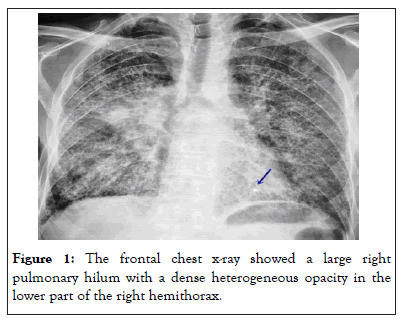
Figure 1: The frontal chest x-ray showed a large right pulmonary hilum with a dense heterogeneous opacity in the lower part of the right hemithorax.
It also showed a metallic image that seemed to be in the right cardiac chamber subject to a location that remained difficult to determine with precision because of artefacts due to the metal (Figure 2).
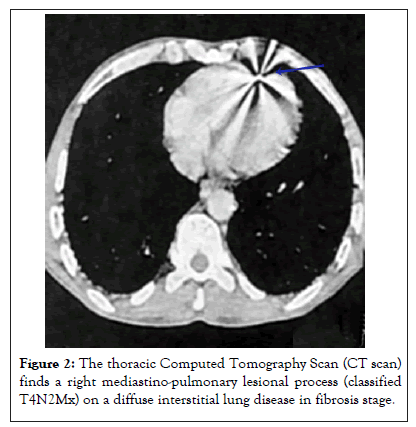
Figure 2: The thoracic Computed Tomography Scan (CT scan) finds a right mediastino-pulmonary lesional process (classified T4N2Mx) on a diffuse interstitial lung disease in fibrosis stage.
Upon inquiring with the patient, it turned out that he is an old fantasia horse rider and that he had been victim of an accidental shooting with a firearm during a fantasia performance 15 years earlier that concerned the left leg. However, the ballistic characteristics of the firearm used weren’t well known by the patient (Figures 3 and 4).
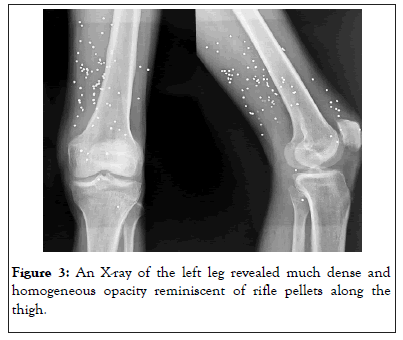
Figure 3: An X-ray of the left leg revealed much dense and homogeneous opacity reminiscent of rifle pellets along the thigh.
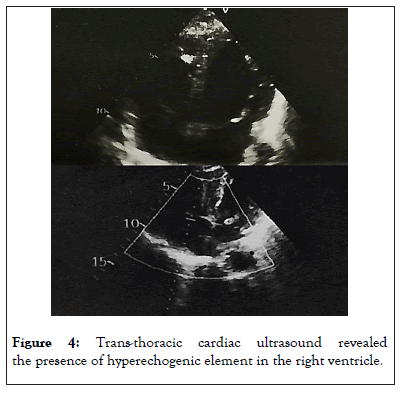
Figure 4: Trans-thoracic cardiac ultrasound revealed the presence of hyperechogenic element in the right ventricle.
Since this element wasn’t clinically relevant and as the prognosis was determined by the patient’s lung cancer which was confirmed by bronchial biopsies that were realized during bronchoscopy showing a tumor-like infiltration of the entire bronchial tree with spontaneously haemorrhagic middle lobar tumor bud, without other visible abnormalities are showed in Figure 5, we did not investigate further and the patient was referred to oncology to start his treatment after a tumor extension study revealing multiple bone metastases (Figure 5).
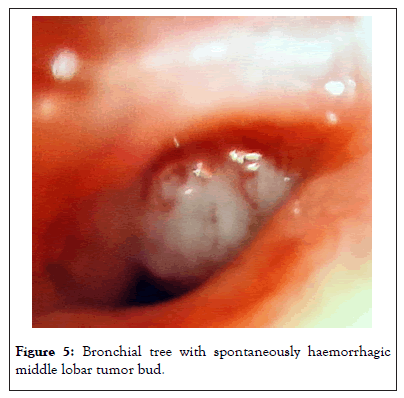
Figure 5: Bronchial tree with spontaneously haemorrhagic middle lobar tumor bud.
Intracardiac migration of a firearm pellet from a peripheral venous trunk is exceptional it represents only 20% of intracardiac migration who remains exceptional and does not exceed 0.3% [3]. The size and the number of pellets on impact influence the risk of migration to cardiac chambers. In 1917, a case of an embolism from the femoral vein to the right atrium following a gunshot wound to the scarpa, was reported, causing patient’s death after a systemic passage of the projectile though a patent foramen ovale.
The intracardiac migration of pellets is asymptomatic in 70% of cases and can occur immediately or lately after 15 years. Moreover, the discovery of an intracardiac projectile is often the result of delay and it’s mostly done by routine chest x-ray, and cardiac ultrasound with colour Doppler that can provide a more precise topographical diagnosis, search for thrombosis and parietal erosion, and more particularly the existence of a patent foramen ovale [4]. Thoracic CT scan can provide a diagnosis when the cardiac ultrasound doesn’t allow localizing the projectile. The pulmonary angiography should be realized if an extraction is indicated as well as the phlebography of the lower limbs to search other intravenous projectiles or underlying venous thrombosis [5].
Even if the intracardiac migration is mostly asymptomatic its risks aren’t negligible. It can cause local, regional and general consequences such as infective endocarditis, pericarditis, valvular lesions, intracardiac thrombosis, cardiac rhythm disorder, pulmonary infarction, and retrograde embolism against venous blood flow in 7% to 15%.
There is also a risk of systemic embolism in case of a patent foramen ovale in 6% to 18% [6].The removal of intracardiac pellets, especially at symptomatic patient and when the pellets exceed 5 mm, decrease the risk of the consequences [7]. In our case it measured 3 mm. Some studies also showed that there was a non-negligible risk when the pellets remain in the vessels, it’s also associated with a risk of complications in 25% and death in 6% and the risk of complication is reduced to 1% to 2% when the pellets is removed [8]. However, extraction should be systematic only in patent foramen ovale, and in the event of complications.
Ballistic vascular migration from venous wound is an exceptional event which can follow a firearm injury in a context of violence or in a folkloric demonstration as in the case of our patient who was a fantasia horse rider. It requires a precise topographical diagnosis to better define the indications for management and extraction. The extraction is reserved for patients with a large intracardiac projectile, patients with a risk of pulmonary artery embolism, and in the event of complications. Conservative management is the first choice in asymptomatic patient with migrating pellets to the heart.
[Crossref] [Google scholar] [PubMed]
[Crossref] [Google scholar] [PubMed]
[Crossref] [Google scholar] [PubMed]
[Crossref] [Google scholar] [PubMed]
[Crossref] [Google scholar] [PubMed]
[Crossref] [Google scholar] [PubMed]
Citation: Natrielli-Filho DG (2023) Intracardiac Migration of a Firearm Projectile in a Fantasia Horse Rider: A Case Report. Acute Chronic Dis. 7:186.
Received: 10-May-2023, Manuscript No. ACDR-23-24033; Editor assigned: 12-May-2023, Pre QC No. ACDR-23-24033 (PQ); Reviewed: 26-May-2023, QC No. ACDR-23-24033; Revised: 02-Jun-2023, Manuscript No. ACDR-23-24033 (R); Published: 09-Jun-2023 , DOI: 10.35248/ACDR. 23.07.186
Copyright: © 2023 Natrielli-Filho DG. This is an open-access article distributed under the terms of the Creative Commons Attribution License, which permits unrestricted use, distribution, and reproduction in any medium, provided the original author and source are credited.